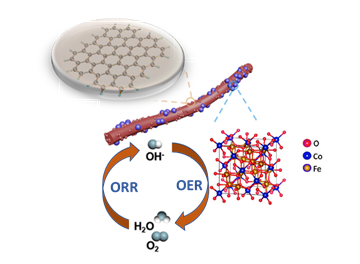
Bifunctional Electrocatalyst Based on Cobalt Ferrite Decorated Porous Carbon Nanofibers as an Air Electrode in Zinc-Air Batteries
Abstract
The scientific and technological advancements have uplifted human civilizations over past several decades. Rapid industrialization has benefitted our society in many ways, however, along with other human impacts and an ever-increasing energy need has adversely affected our climate. For example, burning of fossil fuels produce greenhouse gases which contributes to global warming. To counteract our over-reliance on fossil fuels with detrimental environmental outcomes, we must seek alternative energy sources that are not only greener but also more efficient. Renewable energy sources such as wind, hydel, and solar power are very promising for clean energy production. But these sources are mostly intermittent with strong dependency on geographical location, weather, and time which can be addressed by integration of these with high energy-density storage systems. This is where electrochemical storage devices such as supercapacitors, fuel cells, and batteries come into play. Among these, lithium-ion batteries have been a great success which has impacted and benefitted almost everyone. Yet, their energy density (350 Wh kg−1) and safety concerns has made their large-scale use skeptical. Recently, metal-air batteries specifically zinc based have become the focus of researchers with a targeted energy density of 500 Wh kg−1, lower cost, and much improved safety ratings. However, current Zn-air batteries are not reaching their full potential due to the sluggish nature of oxygen reduction reaction during discharging and oxygen evolution reaction during charging. The multiple proton-coupled electron transfer steps of these reactions result in substantially higher overpotential, smaller current density, and lesser stability, which leads to the poor energy efficiency of less than 65 % of the air cathode. To address these challenges, we have proposed the synthesis of tunable porous carbon nanofibers decorated with nanostructured catalysts. The porosity will enhance the contact area between the electrolyte and the air cathode, and the oxygen transmission path will be effectively shortened, which will provide more active sites for a redox reaction to improve the current density and cycling stability. We designed a highly efficient bifunctional hybrid electrocatalyst based on transition metals and porous carbon nanofibers (CNFs) with a higher active surface area of approximately 485 cm2 and effectively improved passage of oxygen and an efficient in and out movement of the electrolyte. The catalyst was synthesized using electrospinning to obtain CNFs followed by calcination to create porosity and then deposition of highly crystalline CoFe2O4 nanostructures through the hydrothermal method. For oxygen evolution reaction, CoFe2O4@PCNFs required an overpotential of 220 mV at the current density of 10 mA/cm2. The kinetic analysis shows that this catalyst takes only 93 mV of potential to increase the current density by ten folds. For the oxygen reduction reaction, the same catalyst shows an onset potential of 0.81 V and an electron number of 4, which depicts the efficiency of the catalyst and no production of hydrogen peroxide. The internal structure of these catalysts and their surface chemical states are being currently investigated by high resolution transmission electron microscopy and X-ray photoelectron spectroscopy, respectively. These characterizations will provide a baseline to further tune the structures and activity of these catalysts which will then be demonstrated in a prototype zinc-air battery.

